I remember six years ago when I initially began the hunt for a Volkswagen (Vanagon) T3 Syncro, a wise man once said, ‘he who seeketh a Syncro will always pay £15,000 ($20,000) regardless of initial purchase price’. As I gazed up from one knee in awe of the stoic, I finally understood. I may have paid less for mine, but to get something even half-decent, I’d make up the difference in expensive repairs. Now, if the stars aligned, and I once again met that wise old man—well, let’s just say it’s better for him that we didn’t. Sure, £15,000 certainly whet the Syncro’s appetite for cash. Over the last five years, I’ve poured well over double that to finally have a vehicle that’s optimistically a quarter finished. Damn you, stoic. So why choose to be forever cursed by the Vanagon Syncro?

The obvious answer is by mistake. If you want to build a round-the-world expedition truck, there are better base vehicles available (*cough* Toyota). The Vanagon has some big plus points though, namely, the huge online community and the accessibility to original/aftermarket parts (particularly in Europe). There are very few vans with the sheer accessibility of spares as the Vanagon, and that’s reassuring. Moreover, there are a lot of specialists now making upgrades for the Syncro, so you’re often able to fix issues with re-engineered, more durable components.
The Vanagon often gets labelled unreliable, and I think this ultimately reflects their popularity (i.e., the law of averages dictates you’ll hear about more breakdowns) and their prevalence on social media, which ensures issues are more widely broadcasted compared to other vans. Furthermore, Vanagons are generally purchased as a secondary recreational vehicle (often code for ‘maintained on a budget’) and thus more likely to have issues. This reputation for mischief has been bolstered tenfold by the boom of ‘vanlife’ online. The problem here is that many owners invest their entire budget into the van’s aesthetic without a second thought for mechanicals. Consequently, a Vanagon that’s spent its life on a budget and taken short weekend trips to the seaside is suddenly being lived in full-time and driven coast-to-coast in the States without the necessary preventative maintenance. This has resulted in a huge amount of ‘officially joined the Vanagon club’ photos on the back of recovery trucks, hence giving these vans an often unwarranted reputation.


I have owned my Vanagon Syncro for five years and average 25,000 miles annually across mountain ranges, in extreme hot/cold climates, on all possible surfaces. I have had only one breakdown, and even then, it was running, just losing coolant). I’ve spent the entirety of my budget on servicing and generally changed old components way before they had a chance to let me down on the road. Moreover, this is my only vehicle (and home). I’ve spent so much time at the wheel that I hear/feel even the slightest irregularity, thus allowing me to quickly identify issues and hopefully fix them before an actual break-own. Amazing—so the Vanagon is secretly ultra-reliable and just misunderstood?
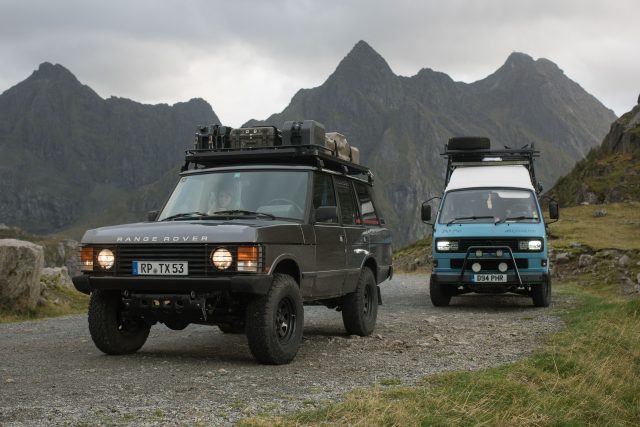
No, I wouldn’t go that far. The Vanagon is much better than people make out, and I do generally trust it for my everyday vehicle, but there are some things to consider. The gearbox was made to handle the underpowered stock engines (oh, don’t worry, we’re coming to that), and subsequently, they’re prone to fail if treated unsympathetically. Gearbox issues are arguably even more commonplace in the Syncro, which features a super useful but more fragile G (crawler) gear. I’m often met with dismay when I tell people I invested in a full rebuild of my stock 1.9 WBX instead of opting for a more powerful and readily available conversion. It’s all very well sticking a 150 bhp modern motor into these vans, and I’m sure it feels amazing. But if your gearbox is stock/original, there’s a good chance it’s going to fail under the stress (especially if you’re going to be tackling more challenging terrain). It’s excessive modifications to these vans that also contribute to their bad reputation, and I think sometimes you have to ask yourself whether you know better than Volkswagen. (I will say that with proper planning, informed modifications, and deep pockets, anything is possible). Thus, I decided to keep my stock 76 hp engine and put the least amount of stress on my gearbox and running gear. Yes, 76 hp.
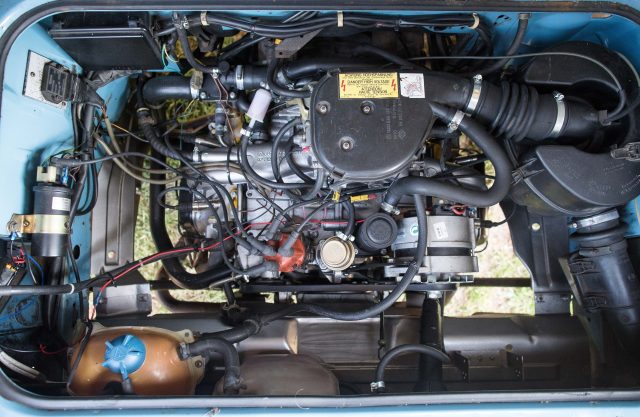
I know what you’re thinking—that is woefully underpowered—and, in a word, yes. I can’t tell you how tempted I was to replace my little WBX with a Subaru or similar, but as discussed above, it’s not that simple. It’s important to remember that more often than not, big decisions like this have a knock-on effect, and you can hastily fix one problem that creates ten more. I would love more power, better fuel economy, and truthfully, a Toyota Troopy, but that’s life. Sure, my 1.9 DG engine is underpowered, but it always gets me where I’m going. The van cruises at 50-60 mph (70 mph in a hurry), I get 25 mpg on a run, it doesn’t overheat, and most importantly, I know it inside out. It’s very easy to get transfixed on figures, but ultimately, you just want an engine that’s reliable, and if it does go wrong, you can fix it (parts, specialists, and even off-the-shelf replacements are a phone call away with the WBX). Moreover, the engine’s torquey enough that 76 hp feels acceptable. And off-road, the G gear, combined with the Steyr-Puch four-wheel-drive system, makes it unquestionably capable when the tarmac ends.
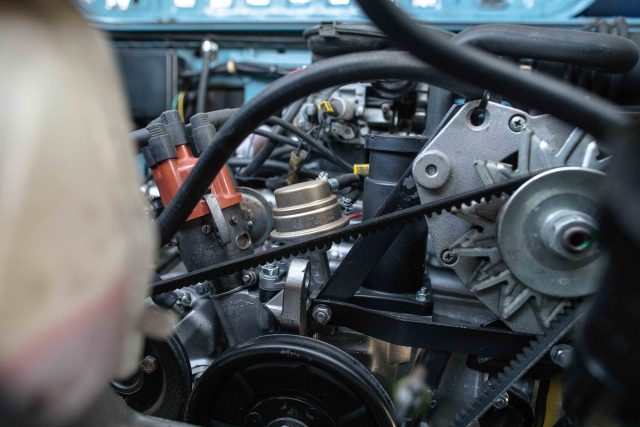

Steyr-Puch is a long-established Austrian company best known for their rugged adventure vehicles and four-wheel-drive systems (examples include the 4WD/6WD Pinzgauer, original Fiat Panda’s 4WD, and one of my favourites, the monster Steyr 12m18). One of its most famous contributions was the four-wheel-drive system fitted to the Volkswagen Vanagon to create the Syncro (largely for the German military service and also very popular in the Swedish army). Some vans, including mine, came with both front and rear vacuum-operated locking diffs that transformed the performance on the rough stuff. The agility of a stock tin-top Syncro with twin diffs is genuinely impressive and would give a lot of more notable overland vehicles a run for their money.

However, if, like me, you’ve built a top-heavy home-on-wheels, then you’re going to sacrifice a significant amount of technical 4WD performance, and that’s just fine. I didn’t build my Syncro to be a weekend ‘green laner’ but an ‘overlander’. I want to go round obstacles instead of over them when possible, but know that when I inevitably do tackle a challenging route, my vehicle will take care of me. It’s important to recognise that most overlanders aren’t pushing their vehicles to the limit but drive sympathetically to increase longevity. Every time I’ve taken unnecessary risks, I’ve either paid the price or been a nervous wreck afterwards. I’m not afraid to rough up the Syncro, but it has to be for a good reason, and needless abuse will only put unnecessary strain on just about everything. The four-wheel drive, locking diffs, winch (not yet fitted), and recovery gear give me the confidence to tackle the road less travelled, and for that, I’m grateful. I’m currently in the process of refreshing my stock suspension setup with heavier-duty Schwenk springs, and either Old Man Emu or Bilstein B6 shocks better suited to my van’s setup. I may also consider Porsche CVs for improved articulation. There are undoubtedly better 4WD drive vehicles for tough terrain. Yet there are fewer that offer such comfortable living accommodation within external dimensions no bigger than a standard parking space.
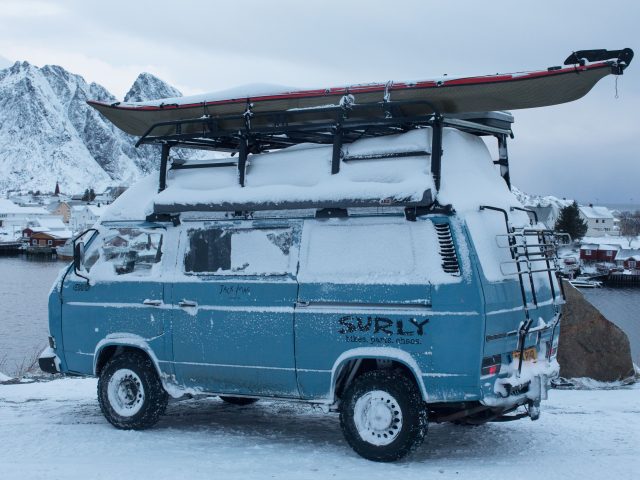
The Syncro is the perfect size for me. There is a small selection of other 4WD vans to consider in this category, including the older Iveco Daily, Mercedes Sprinter MWB, Mercedes 308d, Mitsubishi Delica, and Toyota Hiace, to name a few. However, due to the popularity of the Vanagon (which the Syncro shares almost all components with except the 4WD system), it has arguably better access to parts than the alternatives (at least here in Europe). The reason the Syncro offers such generous interior dimensions despite its modest exterior is due to being—no kind way to say this—a brick. There were far fewer safety regulations back in the 1980s, and subsequently, there is no bonnet or crumple zone (something to consider with old vans). The plus side of driving a death-trap-on-wheels is that the interior space extends the full length of the vehicle to create genuinely impressive living accommodation. I have maximised this floor plan by fitting swivel brackets to both captain chairs in the front, so there’s comfortable seating for four. There’s also an optional rear-facing ‘buddy’ seat that allows a total of five occupants and additional storage (there’s a seatbelt fitted specifically for this chair). As discussed, my van’s interior has always been secondary to mechanical work, so it has only been in the past year that I ripped out the original units.


My objective was to create a minimal yet functional, wipe-clean interior with lockable storage and the flexibility to be rearranged for a variety of purposes. The centrepiece is a Westfalia Mosaik kitchen pod, which despite its age, remains one of the most innovative and well-made cooking/sink/storage solutions for the Vanagon (it’s also made to recess into the rear wall cavity making the absolute most of the space). The old cupboards ran the full length of the van, so these were mostly removed (apart from the rear cupboard) to create room on either side of the new kitchen. This layout means I can slide my ARB compression fridge between the Westy unit and driver’s seat, whilst the rear bench now extends the full width of the van so I can finally sit with my legs up. Moreover, if I want to store/work on my mountain bike, then it can be wheeled in widthways as the ARB fridge can be relocated to the extended bench (this is also nice if I’m leaving the van and want the bicycle to be extra secure). I recently removed the white high top and replaced it with an original VW ‘bread loaf’ roof that’s a far better fit and has increased storage in the secure locker above the cab. The bed is a modified Westfalia and folds out with ease to create a modest double for me and my dire loneliness. The interior is very much a work in progress, but I’m very happy with the basic layout, which prioritises space over storage (there’s a temptation to fill the latter).


I keep my life organised thanks to the Westy unit, overhead locker, unused top-bunk, under-seat storage, rear cupboard, seat organizers, and some small net pockets. In addition, I’ll be adding a product by Vogel Werks Designs that adds an innovative storage compartment inside the tailgate, an underfloor tool locker, the GoWesty underslung storage box (replaces spare wheel that has been relocated), a 50-litre custom underslung water tank, and UV light filtration system. I had a custom roof rack built to carry my Thule Alpine roof box, spare wheel, and sea kayak. Lastly, there’s currently a Paulchen bike rack that will most likely be replaced with a GoWesty swing-away system (but undecided). The van has been home to five smelly men for two weeks in the middle of the Spanish summer, and whilst I had to burn the interior afterwards, it was truly astonishing that we could all sleep inside—although death would’ve been more comfortable. I recently transitioned to fully remote work and invested in a new battery setup capable of supporting my power requirements.



I spent the first three years of vanlife with a decrepit old 110ah leisure battery (came with the van) and a robust constitution. I eventually fitted two new 110ah deep cycle batteries, a Victron power management system, and a temporary 80-watt flexible solar panel (with the intention of upgrading to a larger Victron 175-watt rigid panel). However, during that time, I was following the development of lithium batteries with interest, and when a very reasonable, used Goal Zero Yeti 1250 popped up online, I took the plunge. The unit has everything built in so it can be moved around (although very heavy at almost 100 pounds), and I plan to match it with their portable 100-watt briefcase solar panel. Thus, as it stands, my 220ah batteries power my lights, fridge, and Eberspacher heater, whilst the Goal Zero Yeti charges all other electrical devices. I’m well aware that this arrangement is not particularly space or weight efficient, but it was a relatively budget-friendly solution until I have enough savings for the Battle Born lithium system. I think many people assume you need to have it all figured out before hitting the road, but that’s not true.

It’s very easy to watch videos online of vanlifers in beautiful converted Sprinters and feel disheartened about your budget panel van. I spent my savings purchasing my Syncro, and it was pretty darn basic. I had a very old camper interior with working hobs, a couple of dim lights, and a decent amount of cupboard space. That was it. In fact, I lived like that full time for just shy of three years until I added a Propex heater (which I could only power for short periods off my ancient battery). It wasn’t until the end of 2019 that I finally improved my living conditions on the road. The interior may have been basic, but by prioritising investment in mechanicals, I had a Syncro that took me across Europe without issue and gave me experiences that changed my life forever.


When drawn to spend a fortune on fancy interior upgrades, overlanding accessories, expedition gear, and the latest tech, it’s important to realise that your travel budget will take the brunt of it. I’ve got into the habit of equating every purchase to tanks of fuel (e.g., if I buy that new pair of shoes for £80, that’s around 300 miles of travelling lost. You can talk yourself into all the things you ‘need’, but in reality, a lot of those items aren’t essential to the journey. There are so many wonderful stories of individuals literally just packing a bag and hitting the road: I’m currently speaking to a guy who drove his almost stock Citroen 2CV4 from Amsterdam all the way to India and back in the 1970s. It’s great to upgrade your rig, but I also believe the best way to discover what you really require is to just get out there and explore (although perhaps something more local before you head to India).
There are some truly epic vehicles featured on Expedition Portal. In fact, I decided after reading about some of them that perhaps my Syncro was actually a ‘shed-on-wheels’. The time and thought that has gone into these overlanding rigs blows my mind and inspires me infinitely. That said, I’ll stick with my Syncro. I’m bound to it—a sailor tethered to the mast of his sinking ship. This Syncro is the culmination of blood, sweat, and tears. We’ve fallen out more times than I care to count, and my wallet hasn’t been seen since 2015. I’ve flirted with just about every other expedition vehicle on the market and always come grovelling back to my cruel mistress. Sure, our lives aren’t perfect, but in the words of Shakespeare on his Syncro, ‘the course of true love never did run smooth’ (-Shakespeare, 1595, at his local VW garage). This van may have emptied my wallet, but it has filled my heart (mainly with debt). The Syncro has been at the centre of life-changing journeys that have really helped me grow as a person. I’ve road-tripped all over Europe with friends/family and built a career I genuinely love, all thanks to this van. It’s kept me safe on some of the most perilous roads in Europe and never left me stranded (yet). It may consume my modest income, but in return, it gives me a life that makes me truly happy.

The Vanagon Syncro is a great vehicle for overland travel if shown the love and attention it deserves. If you’re in the market for a Syncro, it might be worth asking yourself if 4WD is absolutely essential, as the 2WD Vanagon is a lot more affordable and there’s less to go wrong (it’s the 4WD system on the Syncro that’s the most tricky/expensive to repair). There’s a vast array of aftermarket upgrades for the standard Vanagon to make it more capable on the rough stuff. The Syncro may not be one of the most capable 4WD vehicles in the world, but it is arguably one of the best go-anywhere vans and unquestionably a very capable home-on-wheels for international travel.

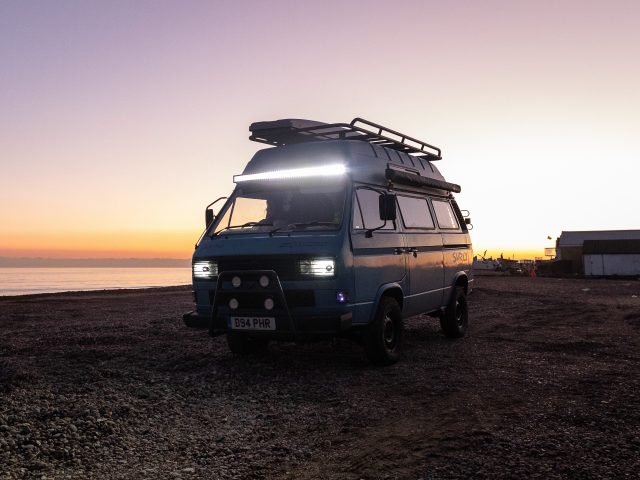

Specifications
1986 Volkswagen (Vanagon) T3 Syncro
Power
1.9 DG Wasserboxer (WBX) petrol engine
4-speed manual gearbox with G ( ‘Gelande’ – cross country) crawler gear
Suspension and Drive
Stock suspension *soon to be Schwenk springs and Old man Emu shocks
Front and rear vacuum-operated locking diffs
Viscowerkstatt Kern viscous coupling
Aghabridge custom propshaft
Wheels and Tires
Mefro steel wheels
BFGoodrich All-Terrain KO2s 215/75R15 tires
Recovery and Armor:
Custom front bull bar
CVC Aluminium recovery tracks
Custom heavy-duty rear hitch
Front to back underside protection
Original snorkel
Deadlocks all round
Accessories:
Westfalia Mosaik kitchen pod
Westfalia front and rear tables
Twin Westfalia front seat swivel bases
Westfalia rock ‘n’ roll bed
Eberspacher B1 heater
ARB 35-litre compressor fridge
ARB awning
Wheeliams custom roof rack
WOW LED Front and back auxiliary Sspots
Autolamps 135 Slimline LED brake/indicators on roof rack
Willpower 52-inch curved light bar
MMT3 Tuning ProjektZwo-style yellow fogs
Overhead cab secure locker
Blazecut fire suppression system
VW LT truck mirrors
Fan-tastic 1200 fan
Molle seat storage system
Vogel Werks Designs Vangaroo tailgate storage system
Power
2 x Enduroline 110ah deep cycle batteries and 80-watt flexible solar
Goal Zero Yeti 1250 (100ah) lithium battery and their Boulder 100w portable solar panel
Victron 1200VA Phoenix inverter
8 x Blue Sea 2.1 amps fast-charging USB ports
Resources [these are companies involved in the project that do not have products listed above]
Haynes Volkswagen Transporter manual: haynes.com
Bentley Publishers Volkswagen Vanagon repair manual: bentleypublishers.com
Busman Europe: busmaneurope.com
Club 80-90 Forum: club8090.co.uk
Our No Compromise Clause: We carefully screen all contributors to make sure they are independent and impartial. We never have and never will accept advertorial, and we do not allow advertising to influence our product or destination reviews.


